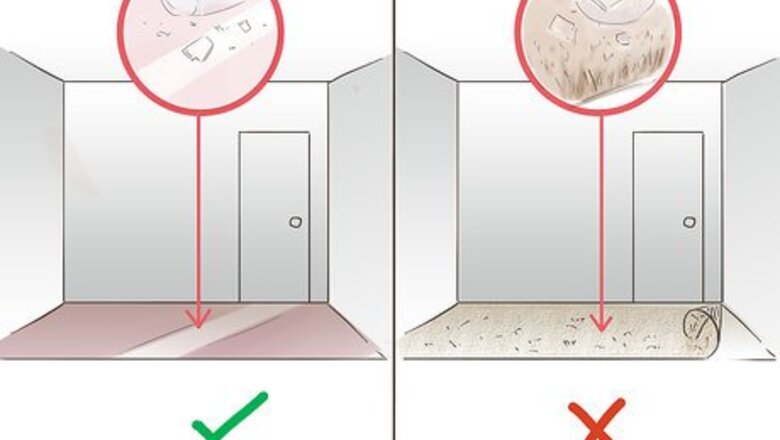
views
X
Research source
This may have led you to wonder, “Could I break a glass with my voice?” While there are many factors that will affect how easily you succeed in this task, with enough time and effort, you may be able to reduce a glass to shards with only your voice.[2]
X
Research source
Setting the Stage for Glass Shattering
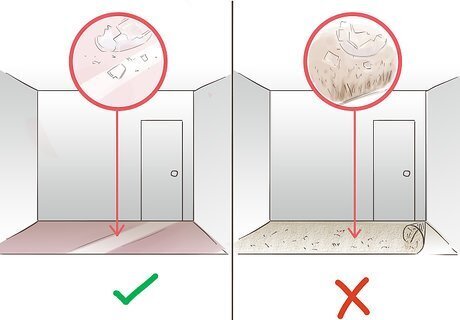
Prepare your glass shattering station. Remember, success in this task will result in broken glass, so you might want to practice in a room with hard floors to make clean up easier. Choose a room with good acoustics and little to no echo. You’ll also need a power outlet to plug in your amp if you've chosen to use a microphone, as well as a platform on which your glass and amp can sit. If you plan on using your voice alone to shatter your glass, you'll only need a sturdy platform to place your glass upon. The platform should be relatively high so that you can stand while singing to get the best volume and tone. Lay down a large drop cloth if you attempt this in a carpeted area. Small splinters of glass can become embedded in carpet and cause harm later. A drop cloth will keep shattered glass from getting in your carpet. When using an amp and microphone, the amp should be placed facing your glass and relatively close to it. A sturdy coffee table might be sufficient to hold both speaker and glass while limiting distorting vibrations, though the ground might also work well. Try to position your amp so it isn’t blasting sound in the direction of people who might be bothered by it, like your neighbors. Your glass should be directly in front of the amplifier's speaker. Look through the material covering the front of your amplifier and find the exact location of the speaker cone. Position your glass right in front of the cone.
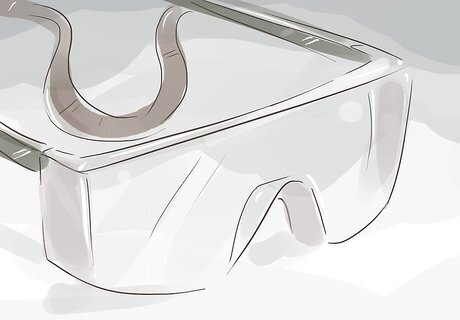
Put on safety goggles/glasses to protect your eyes. Shattering glass can produce very small fragments that can cause permanent damage to your eyes. Wearing simple eye protection, like safety glasses or goggles, will prevent this from happening. If you don’t happen to have protective eyewear handy, you could use a pair of cheap sunglasses or swimming goggles. Be sure that your eye protection covers your entire eye. Half-lens reading glasses will not be adequate.

Find the resonant frequency of your glass. Flick the glass with your fingernail gently and listen carefully to the ringing sound. This is the resonant frequency of your glass, and you will have to match and sustain this pitch to cause it to break. It may help you to hold onto the pitch if you hum it softly to yourself even after the glass has finished ringing. You can also cause your glass to hum its resonant frequency by moistening your finger and rubbing it along the rim of your glass. Circle the rim of the glass with your finger until it resonates audibly. Then try to hold that pitch in your head. You may find using an instrument or tool, like a piano or a pitch finder, can help you identify, hold, and narrow in on the resonant frequency while you’re trying to sing. Empty your glass completely, remove decorations from it, and place it on a sturdy, regular surface while you are checking its resonant frequency. Things that are inside, on top of, or connected to your glass could alter this tone.

Maintain the resonant frequency in your mind. Holding a pitch in your head for a period of time usually results in a flat pitch. A flat resonant pitch won't make your glass shatter. To help prevent yourself from going flat, you may want to hum along or sustain the note with some kind of tool, like an instrument, pitch pipe, or pitch finder/tuner. Hearing very slight differences in tone can be difficult even for talented musicians. Check your pitch frequently as you attempt to shatter the glass with your voice. Simply flick the bulb of the glass gently with your fingernail, listen carefully to the resulting tone, and tweak your pitch to match it.
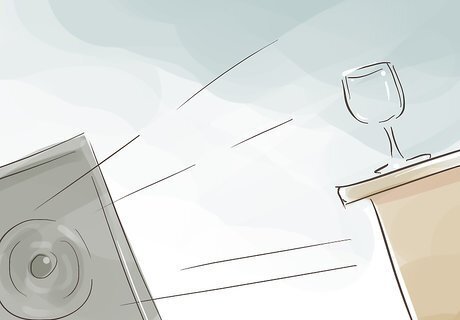
Aim for a loud volume a pure resonant pitch. Professional vocalists and opera singers are generally the people who attempt this kind of feat due to their vocal strength. You'll need to at least reach a volume of 100 - 110 decibels and match the resonant pitch perfectly for several seconds if you're going to shatter a glass. This can be a difficult feat if you are untrained, in which case you might use a microphone. The 100 - 110 decibel range is similar to the noise produced by a nearby power mower, power saw, or motorcycle. To shatter glass, you'll have to reach this volume or louder while singing the resonant pitch.
Breaking a Glass with Your Voice Alone

Place your mouth close to the glass. With enough practice and vocal strength, you should be able to shatter a glass from a more comfortable distance. Most normal people, however, will have difficulty sustaining the volume necessary for breaking a glass. Being very close will focus your sound energy and give you the best chance possible of making it break. To check just how loud you are singing, you might want to download a sound measuring app from the app store on your phone or buy a sound level meter from an online retailer. If you notice that, even at your loudest, you're nowhere close to the 100 - 110 decibel range, you might want to consider using a microphone.

Sing the resonant frequency pitch. Begin singing the resonant tone at a normal speaking volume. Listen carefully to the sound of your voice. Does it sound sharp (above the resonant pitch) or flat (below the resonant pitch)? If so, make slight adjustments to your tone. When you are confident that you are singing the pitch perfectly, slowly increase your singing volume into you are singing as loudly as you can. If you feel discomfort, pain, or notice a significant change in the quality of your voice, you may be straining your voice by singing too loudly or too long. To prevent permanent damage, you should stop immediately, drink some water. Hold off singing until your voice is back to normal. Vowel sounds will be less obstructed, enabling you to achieve higher volumes. In particular, the "ee" vowel sound has the highest volume rating. The vowel “ay” is also rated very highly for volume. Sustain your note as long as possible while making slight adjustments. Even if you hit the resonant frequency dead-on, you’ll have to hold the pitch perfectly for a few seconds before the glass vibrates enough to shatter. More likely you’ll have to “slide” your voice slightly up and down and make slight adjustments to match the resonant pitch.

Attempt shattering different glasses. Some glasses will have more microscopic imperfections than others. More imperfections in the glass means you’ll have a better chance of causing it to shatter. By rotating between several different glasses, it’s more likely that at least one will have the imperfections you need to break the glass. You might also want to try glasses of various shape and size. Be sure you check the resonant frequency of each glass with a flick of your nail; each glass will have its own slightly different resonant frequency.

Dispose of the broken glass carefully when you succeed. Wear gloves when cleaning up to prevent yourself from getting cuts or scraped by a sharp edge. Then examine the area thoroughly to make sure you've picked up even the smallest fragments. A flashlight can help you spot small slivers. You may want to avoid using a vacuum cleaner to suck up your glass fragments. Doing so can cause damage to your vacuum. Instead, sweep up as much as possible with a broom, and capture tiny slivers by pressing a piece of bread into the fragments.
Breaking a Glass with a Microphone
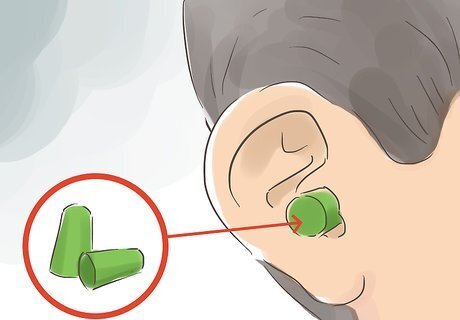
Protect your hearing. The amplifier will need to be turned up fairly loud in order for this to work, so you should protect your ears from potentially harmful sound levels. A good pair of earplugs might be sufficient, but for very loud volumes, specialty sound dampening ear protectors might be best.

Prepare your amplifier. Plug in and switch on your amp. You should hear a faint tone caused by the electricity running through it. This means your amp is ready for input. Take the cord end of your mic and plug its audio jack into your amp. You’ll also need to plug a microphone into your amplifier. You should place your mic as far away from the amplifier as the cable will allow to prevent distortion and mic feedback. Use a microphone stand if you have one available. Singing hands free will allow you to focus more intensely on the task at hand. Remember to wear your ear protection. Also, to minimize your exposure to loud volumes, you should stand behind the amp, or behind it and off to the side. If your mic doesn’t work, check it for an on/off switch. If your mic is already switched on but still is not working, check the audio jack to make sure your it is fully connected to the speaker.
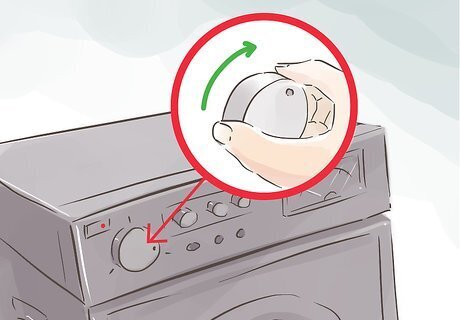
Adjust the volume of your amp. If you are using an unfamiliar amp, test its volume at a medium level before attempting to put it on the maximum setting. Most glasses will require you to reach a minimum of 100 to 110 decibels, which is about the volume of a passing motorbike, a nearby car horn, or the music in a nightclub. You may want to layer the wall your amp is pointed at with sound dampening material, like heavy blankets or cushions. This will prevent the loudness of your amp from aggravating others. Other sound dampening measures you might make use of include acoustic panels, soundproof curtains, and other techniques.
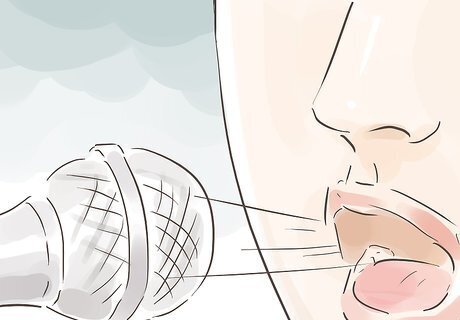
Sing into the microphone. You’ll want to save your voice from unnecessary strain by singing at a soft to moderate volume. Slide your voice in very small increments around the resonant pitch until you feel confident that you have it perfectly. Then increase your volume until you are singing into the microphone directly at a moderate volume. If your glass refuses to break, check your pitch with a pitch finder. The pitch you are singing might only be off a slight bit, but this can prevent your glass from breaking. Vowels are less obstructed and will help you to achieve louder volumes. In particular, the "ee" vowel sound has the highest volume rating. The vowel “ay” is also rated very highly for volume. Sustain your note as long as possible while making slight adjustments. Even if you hit the resonant frequency dead-on, you’ll have to hold the pitch perfectly for a few seconds before the glass vibrates enough to shatter. Since you are using amplification, you shouldn’t need to shout into the microphone. Speaking loudly puts strain on your voice and can do permanent damage if you’re not careful. Sing into the microphone at a moderate volume and take a break whenever your voice feels tired.

Dispose of the broken glass carefully. A pair of rubber gloves will help prevent you from getting any nicks or cuts from the glass while cleaning. You may want to use a flashlight to help you find difficult to see fragments. Pick up and throw away large pieces of glass with your hands, sweep up smaller fragments, and use care when vacuuming. Glass fragments may cause damage to your vacuum cleaner. A common trick for picking up small shard and slivers of glass uses a slice of soft sandwich bread. Press your bread into the floor wherever you see glass. The glass should get caught into the bread, which you can throw away when the glass is clean or the piece of bread is full of glass. You may need to use several pieces of bread to clean the entire area.



















Comments
0 comment